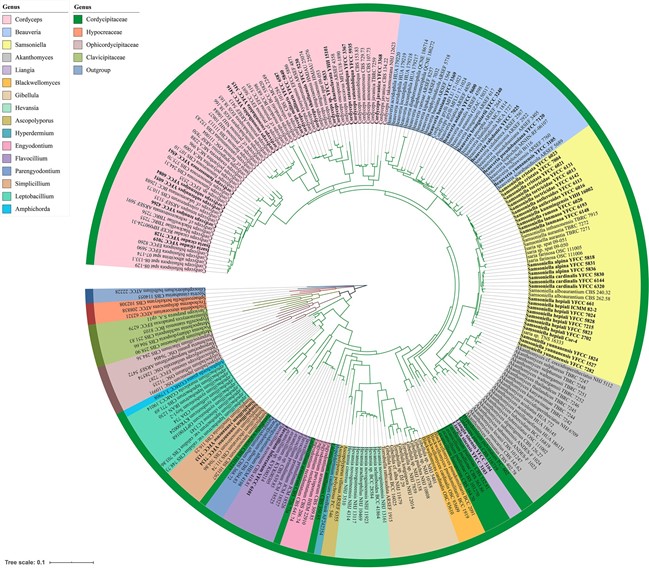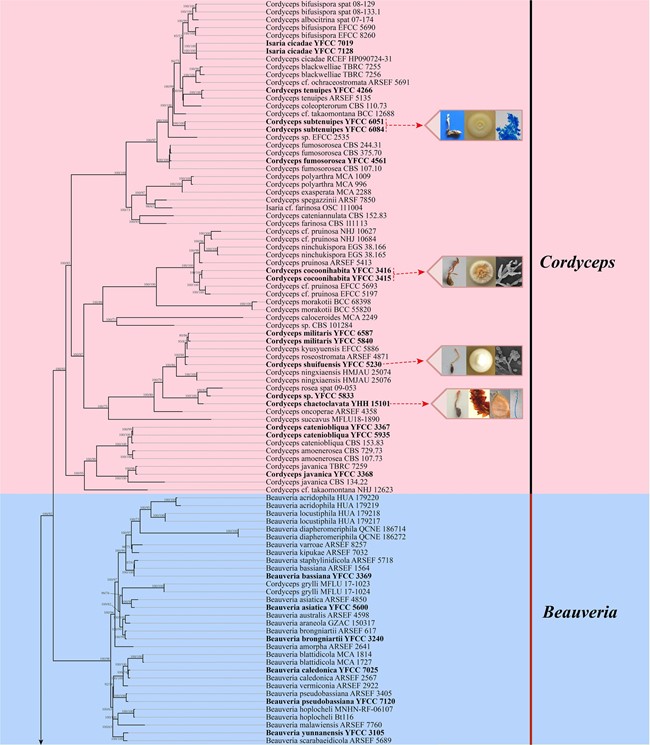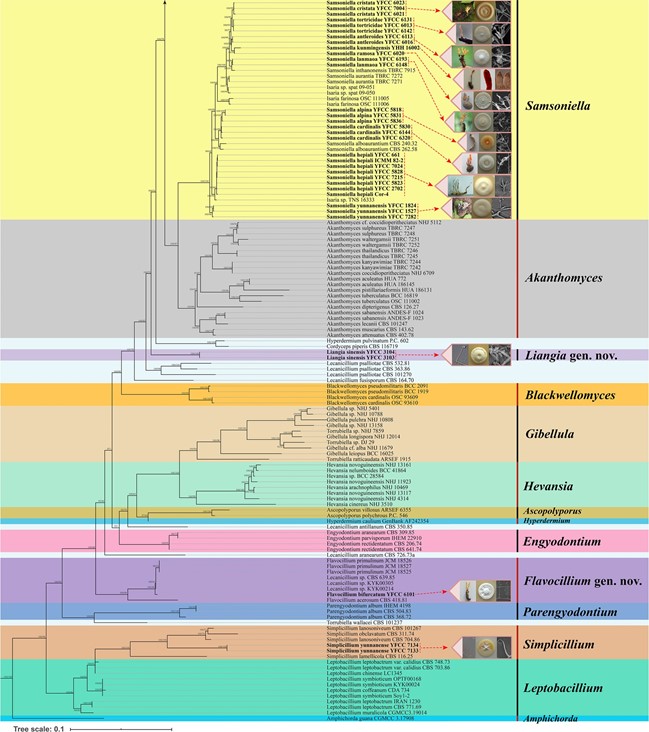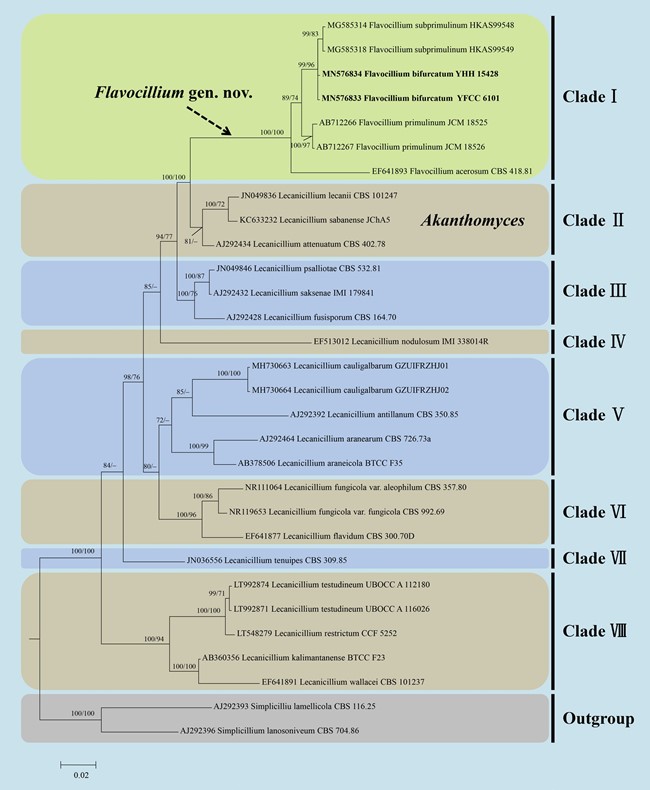Flavocillium H. Yu, Y.B. Wang, Y. Wang, Q. Fan & Zhu L. Yang, gen. nov.
Index Fungorum number: MB 833094; Facesoffungi number: FoF14501
Etymology: Referring to the yellowish stromata and colonies.
Sexual morph: Stromata arising from the insect buried in soil, clavate to flake-like, solitary, flexuous, yellowish, fleshy, up to 5 cm long, with a furcate terminal branch; stipe clavate, flexuous; fertile part contorted, clavate; perithecia densely packed, yellowish.
Asexual morph: Lecanicillium– like. Colonies yellowish, slow-growing. Conidiophores mononematous, cylindrical, with two to five phialides at the terminal nodes. Phialides lanceolate, solitary or in whorls of two to five, tapering gradually toward the apex. Two types of conidia hyaline, one-celled and smooth-walled, single or usually aggregate in subglobose to ellipsoidal heads at the apex of the phialides. Macroconidia fusiform, cymbiform or ellipsoidal to cylindrical. Microconidia oval to ellipsoidal or fusiform.
Type species: Flavocillium bifurcatum H. Yu, Y.B. Wang,Y. Wang, Q. Fan & Zhu L. Yang.
Notes: – Five-gene phylogenetic analyses show that L. acerosum, L. primulinum, Lecanicillium sp. and our samples (YHH 15428, YFCC 6101) group together, in a monophyletic clade in the family Cordycipitaceae (Fig. 1, 2). This L. primulinum clade is clustered in the subbasal portion of phylogenetic tree within Cordycipitaceae and has a close phylogenetic relationship with Engyodontium and Parengyodontium, but forms a distinct lineage. ML and BI phylogenetic analyses based on ITS sequences from 30 taxa in Lecanicillium and Simplicillium show that the Lecanicillium group is polyphyletic and consists of eight monophyletic clades (Fig. 3). The L. primulinum clade includes L. acerosum, L. primulinum, Lecanicillium sp., L. subprimulinum and one new species with yellowish stromata (Fig. 3). This result is also supported by the previous phylogenetic analyses of Lecanicillium species from a combined nrSSU, nrLSU, tef-1 and ITS sequence dataset (Huang et al. 2018). In this clade, L. acerosum was first described by its distinguishing morphological characteristics producing the large straight macroconidia (Zare and Gams 2001). Recently, two species (L. primulinum and L. subprimulinum) producing pastel yellow pigment were added, which were respectively isolated from soil and an ophioceras-like taxon on the dead submerged wood (Kaifuchi et al. 2013; Huang et al. 2018).
Morphologically, the L. primulinum clade is similar to other Lecanicillium species in terms of conidiophores, phialides and two types of conidia (Zare and Gams 2001; Zhou et al. 2018). However, these species of Flavocillium possess yellowish stromata with a furcate terminal branch, contorted fertile parts with yellowish perithecia and colonies that usually produce pastel yellow pigment, are obviously different from other members of the Lecanicillium lineage. In addition, the L. primulinum clade also can be distinguished from these phylogenetically related genera Engyodontium and Parengyodontium based on the morphological characteristics of the latters, both of which usually produce white colonies, conidiiferous rachids with denticles on phialides and terminal fertile regions that are zigzag-shaped (Gams et al. 1984; Tsang et al. 2016). Therefore, the new genus Flavocillium is introduced by the type species F. bifurcatum in order to accomodate the three following new combinations previously treated as members of Lecanicillium.

Fig. 1 Phylogenetic tree of Cordycipitaceae and related families inferred from a multigene dataset (nrLSU, nrSSU, tef-1α, rpb1 and rpb2) based on maximum likelihood (ML) and Bayesian inference (BI) analyses. Families of Hypocreales and genera of Cordycipitaceae are differentiated with different colors. Phylogenetic relationships among families of Hypocreales are strongly supported by ML boot- strap proportions and BI posterior probabilities (BP ≥ 70%, PP ≥ 95%)

Fig. 2 Phylogenetic relationships among genera and related species in the family Cordycipitaceae inferred from a multigene dataset (nrLSU, nrSSU, tef-1α, rpb1 and rpb2) based on ML and BI analyses. Values at the nodes before and after the backslash are BI posterior prob- abilities and ML bootstrap proportions, respectively. Support values greater than 50% are indicated at the nodes

Fig. 2 (continued)

Fig. 3 Phylogenetic relationships of the genus Flavocillium and related Lecanicillium species in the family Cordycipitaceae inferred from ITS sequences based on ML and BI analyses. Statistical support values greater than 70% are shown at the nodes for BI posterior probabilities / ML boostrap proportions. Simplicillium lanosoniveum CBS 704.86 and Sim. lamellicola CBS 116.25 were designated as the out- group taxa
Species
